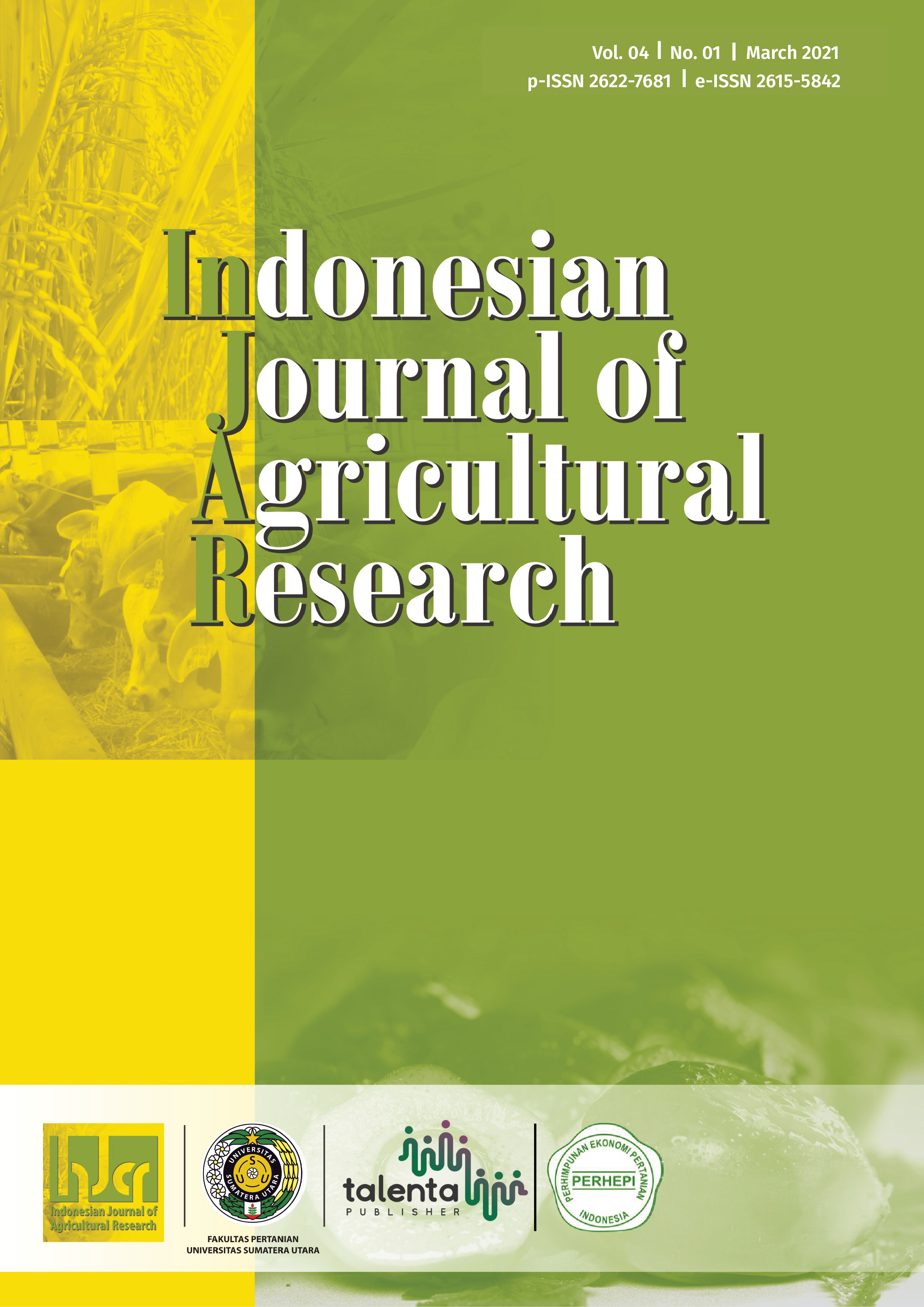Factors Determining Choice of Conventional Labour Among Yam Producers in Benue State of Nigeria
DOI:
https://doi.org/10.32734/injar.v4i1.5138Keywords:
Benue State, choice, farmers, labour, Nigeria, yamAbstract
The present research empirically determined the factors that influenced the choice of combined labour for efficient yam marketable surplus in Benue State of Nigeria. 2016 cropping season cross-sectional data elicited by structured questionnaire complemented with interview schedule from a total of 120 farmers chosen through a multi-stage sampling technique was used. The instruments used for data analysis were descriptive and inferential statistics. The empirical evidences showed that decision for choice of efficiently combined labour that is supplemented by paid labour for efficient yam marketable surplus was affected by low yam productivity and low income which largely owed to poor proceeds from product marketing. Gender stereotype due to culture and religious barriers affected women access and control to productive access, thus hinders women active involved in yam entrepreneurship as they cannot carter for paid labour. Thus, it can be inferred that utilization of combined labour was affected by poor yield, gender stereotype and poor economic capital. Therefore, for farmers to be able to harness combined labour efficiently for a good marketable surplus, thus a better wellbeing for farmers, farmers need technical guided on potential yield; provision of buffer stocks for a remunerative price normalization; and, breaking the jinx of gender inequality through tacit sensitization in the studied area.
Downloads
References
J. D. Arikpo, et al., “Economic analysis of variables affecting the plantain (Musa sp) mono cropping system of production by small-scale farmers in central Cross River State, Nigeria,†Journal of Agriculture, Forestry and Social Sciences, vol. 7, no. 2, pp. 75-87, 2009.
N. E. Bassey, A. J. Akpaeti, and U. J. Udo, “Labour choice decisions among cassava crop farmers in Akwa Ibom State, Nigeria,†International Journal of Food and Agricultural Economics, vol. 2, no. 3, pp. 145-156, 2014.
L. Bervidova, “Labour productivity as a factor of sustainable economic development of the CR agriculture,†The Agricultural Economics, vol. 48, no. 2, pp. 55-59, 2001.
C. O. Anyiro, C. O. Emerole, C. K. Osondu, S. C. Udah, and S. E. Ugorji, “Labour-use efficiency by smallholder yam farmers in Abia State Nigeria: A labour-use requirementfrontier approach,†International Journal of Food and Agricultural Economics, vol. 1, no. 1, pp. 151-163, 2013.
K. A. Oluyole, O. A. Egbetokun, O. A. Oni, and E. O. Aigbekaen, “Technological changes and labour demand among cocoa farmers in Nigeria,†World Journal of Agricultural Sciences, vol. 7, no. 5, pp. 638-641, 2011.
C. Kadurumba, C. N. Uche, and M. S. Omole, “Labour-use efficiency by smallholder rice farmers in Ebonyi State Nigeria: A labour-use requirement frontier approach,†International Journal of Agriculture and Rural Development, vol. 23, no. 1, pp. 4821-4829, 2020.
I. A. Ajibefun, G. Ademola, and A. Obioma, “Investigation of factors influencing technical efficiency of small-holder crop farmer in Nigeria,†CEPA Working Papers No. 10/96. Department of Economics, University of New England, 2000.
National Population Commission (NPC), National population commission, Census Report, 2006.
G. A. Churchill, “A paradigm for developing better measures of marketing constructs,†Journal of Marketing Research, vol. 16, no. 1, pp. 64-73, 1979.
R. Ullah, M. Rehman, M. Anjum, M. A. Kamran, K. Bakhsh, and A. Saboor, “Navigating farming risks by simultaneous diversification and credit through formal and informal communication channel,†Pakistan Journal of Agricultural Research, vol. 29, no, 4, pp. 381-391, 2016.
P. Idisi, S. E. Ebukiba, and L. Anthony, “Socio-economic factors influencing yam (Dioscoreaspp) production in Bwari Area Council, Abuja, Nigeria,†Journal of Agriculture and Veterinary Science, vol. 12, no. 3-I, pp. 78-85, 2019.
M. C. Nwike, T. O. OKoli, and C. O. A. Ugwumba, “Economics of water yam (Dioscoreaalata) Production in South Eastern Nigeria,†Journal of Agriculture and Veterinary Science, vol. 10, no. 7-II, pp. 13-18, 2017.
C. A. Otekhile and N. Verter, “The socioeconomic characteristics of rural farmers and their net income in Ojo and Badagry Local Government Areas of Lagos State, Nigeria,†Acta Universitatis Agriculturae et Silviculturae Mendelianae Brunensis, Mendel University Press, vol. 65, no. 6, pp. 2037-2043, 2017.
Downloads
Published
How to Cite
Issue
Section
License
Copyright (c) 2021 Indonesian Journal of Agricultural Research

This work is licensed under a Creative Commons Attribution-ShareAlike 4.0 International License.



















